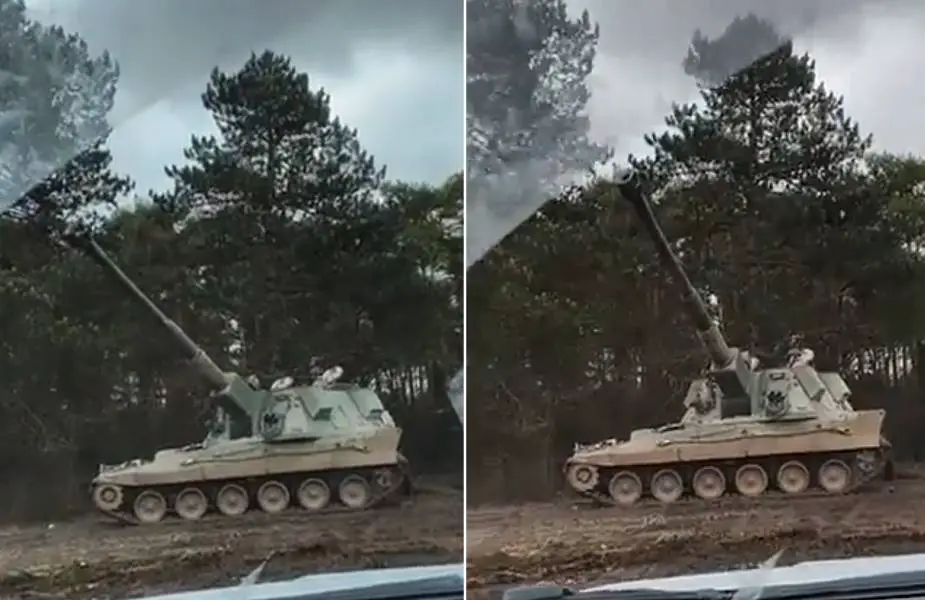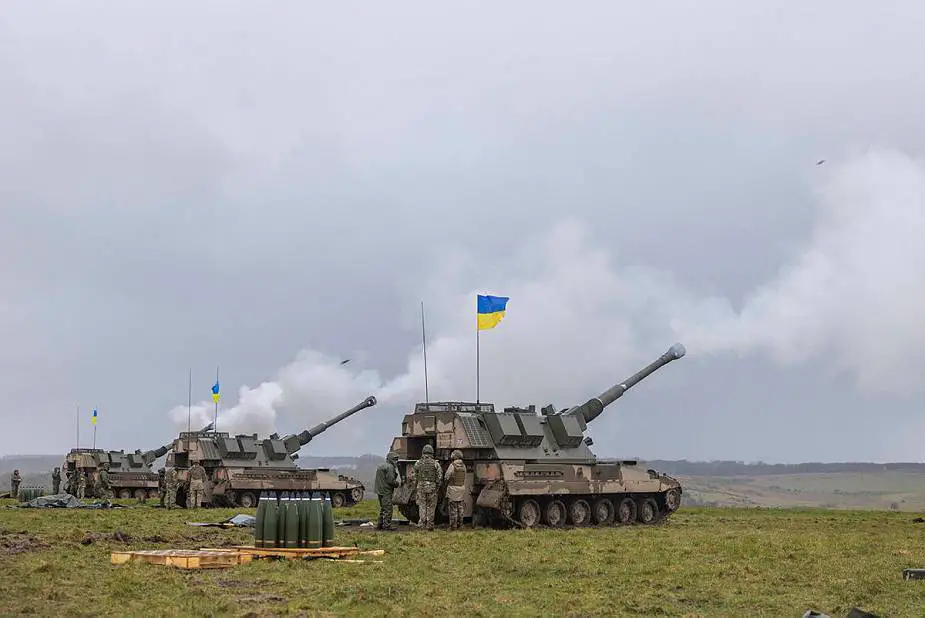According to a video published on the "Special Kherson Cat" Twitter account on April 26, 2023, the AS90 155mm tracked self-propelled howitzers donated by the United Kingdom to the Ukrainian army, is now ready to be operated in Ukraine and to shell Russian troops.
Follow Army Recognition on Google News at this link

AS90 155mm tracked self-propelled howitzers donated by the UK are now deployed on Ukrainian territory and ready to shell Russian troops. (Picture source Twitter account video footage Special Kherson Cat)
The United Kingdom has committed to offering military assistance to Ukraine in its continuing offensive, as declared by UK Prime Minister Rishi Sunak on January 16, 2023. This support entails the provision of 30 AS90 Braveheart 155mm self-propelled, tracked howitzers.
In late March 2023, the UK Ministry of Defence (MoD) revealed that a second batch of Ukrainian troops had successfully finished their training on the British AS90, a 155mm self-propelled, tracked howitzer. Throughout the training, the soldiers participated in live-fire drills.
Officially, the British government had not yet formally announced that the first AS90 howitzers had arrived in Ukraine, but the video posted on Special Kherson Cat's Twitter account confirms that several of these artillery vehicles are indeed on Ukrainian territory.
Currently, the Ukrainian armed forces use several Soviet-made self-propelled howitzers such as the 2S1, 2S3 and 2S19 as well as PzH 2000 donated by Germany, Netherlands and Italy, Krab from Poland and several M109 155mm self-propelled howitzers.
In the ongoing Russia-Ukraine War, the AS90 British howitzer has emerged as a more advanced and capable artillery system compared to the Soviet-era 2S1 Gvozdika, 2S3 Akatsiya, and 2S19 Msta howitzers.
The AS90 Braveheart, with its 155mm caliber, offers a significant advantage in terms of range. It is capable of reaching targets up to 24.7 km away with standard charges and up to 30 km when using base bleed or rocket-assisted projectiles. This extended range is particularly useful in the context of modern warfare. Moreover, the AS90's rate of fire surpasses that of its Soviet counterparts, allowing for rapid engagement of enemy positions.
Furthermore, the AS90 benefits from a more sophisticated fire control and navigation system, which results in greater accuracy and faster response times. These features make it a formidable asset on the battlefield, as it allows for more precise targeting and quicker adjustments.
On the other hand, the older Soviet-era howitzers, such as the 122mm 2S1 Gvozdika and 152mm 2S3 Akatsiya, have a shorter range and slower rate of fire compared to the AS90. Their fire control systems are also less advanced, leading to decreased accuracy and longer response times.
While the 152mm 2S19 Msta is an improvement over the 2S1 and 2S3, with a comparable range to the AS90, it still lacks the advanced fire control system found in the British artillery system. This ultimately results in a less accurate and less responsive artillery platform compared to the AS90.

Ukrainian soldiers train with British AS90 155mm tracked self-propelled howitzers under the control of the Royal School of Artillery and is conducted by officers and soldiers of the Royal Regiment of Artillery. (Source picture British MoD)
The British AS90 also offers a higher firing rate and enhanced mobility capabilities compared to the Soviet-era 2S1, 2S3, and 2S19 tracked self-propelled howitzers.
The AS90 howitzer boasts an impressive firing rate, surpassing that of its Soviet counterparts. In burst mode, it can fire three rounds in 10 seconds, while in intense mode, it can maintain six rounds per minute for three minutes. The sustained firing rate for the AS90 is two rounds per minute for 60 minutes. This rapid rate of fire enables the AS90 to deliver more firepower in less time, effectively engaging enemy positions and suppressing enemy fire.
In comparison, the 2S1 Gvozdika has a sustained firing rate of 4-5 rounds per minute, the 2S3 Akatsiya fires 2.5-3 rounds per minute, and the 2S19 Msta has a maximum firing rate of 6-8 rounds per minute and a sustained rate of 2-3 rounds per minute. The AS90's superior firing rate contributes to its effectiveness as an artillery platform in fast-paced combat situations.
The tracked chassis of the British AS90 provides excellent mobility on various terrains. This mobility allows the AS90 to quickly relocate to avoid counter-battery fire, a critical aspect of modern warfare. Its design also facilitates keeping pace with mechanized and armored units, offering continuous fire support.
The 2S1, 2S3, and 2S19 are also self-propelled, tracked howitzers. However, their overall mobility may be limited due to their older design and less efficient engines. The AS90's modern design and powertrain offer an advantage in terms of mobility. The AS90 can reach a top speed of approximately 53 km/h (33 mph), while the 2S1 has a top speed of 60 km/h (37 mph), the 2S3 reaches 50 km/h (31 mph), and the 2S19 has a top speed of 60 km/h (37 mph). Though the top speeds are relatively similar, the AS90's more advanced powertrain and design allow it to be more agile and maneuverable on the battlefield.
In conclusion, the British AS90 will equip the Ukrainian forces with a significant advantage in terms of range and accuracy. Additionally, it boasts a superior firing rate and enhanced mobility. The advanced fire control system of the AS90 enables improved targeting and responsiveness, rendering it an invaluable resource in the ongoing conflict.














